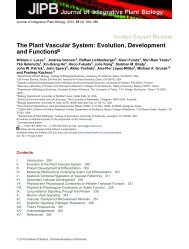Zygomorphy and heterandry in Solanum in a phylogenetic context
Zygomorphy and heterandry in Solanum in a phylogenetic context
Zygomorphy and heterandry in Solanum in a phylogenetic context
You also want an ePaper? Increase the reach of your titles
YUMPU automatically turns print PDFs into web optimized ePapers that Google loves.
much as Bowers (1975) found <strong>in</strong> S. rostratum. The shorter stamens function as “feed<strong>in</strong>g<br />
anthers” <strong>in</strong> attract<strong>in</strong>g floral visitors, whereas the long stamen primarily functions <strong>in</strong><br />
poll<strong>in</strong>ation. Delay<strong>in</strong>g dehiscence of the long stamen may allow the chance for crosspoll<strong>in</strong>ation<br />
to occur. Thus, temporal separation of reproductive events <strong>in</strong> the flower may<br />
be important <strong>in</strong> species with heteranthery but without enantiostyly.<br />
The experimental studies of Jesson <strong>and</strong> Barrett (2005) suggest that significant<br />
<strong>in</strong>breed<strong>in</strong>g depression occurs <strong>in</strong> the self-compatible S. rostratum, despite its highly<br />
modified floral morphology. Factors such as self-<strong>in</strong>compatibility (SI) <strong>and</strong> derived sexual<br />
systems such as <strong>and</strong>romonoecy <strong>and</strong> dioecy affect the degree of outcross<strong>in</strong>g <strong>in</strong> a particular<br />
species or population, <strong>in</strong> addition to floral modifications such as enantiostyly. Outcross<strong>in</strong>g<br />
<strong>in</strong>surance by mechanical means such as heteranthery <strong>and</strong> enantiostyly may be much less<br />
of an issue if a species is self-<strong>in</strong>compatible. Thus, a species breed<strong>in</strong>g <strong>and</strong> sexual system<br />
should also be known when evaluat<strong>in</strong>g the efficacy of heteranthery <strong>and</strong> enantiostyly as<br />
outcross<strong>in</strong>g mechanisms.<br />
Future Directions<br />
This study raises as many questions as it answers <strong>and</strong> suggests many avenues for<br />
future <strong>in</strong>vestigation of floral evolution <strong>in</strong> <strong>Solanum</strong>. Even the most basic <strong>in</strong>formation on<br />
breed<strong>in</strong>g systems, sex expression <strong>and</strong> floral morphology is lack<strong>in</strong>g for many <strong>Solanum</strong><br />
species, so few generalizations can be made about evolutionary patterns at this time. More<br />
extensive sampl<strong>in</strong>g of <strong>Solanum</strong> species may help p<strong>in</strong>po<strong>in</strong>t the sister taxa to species with<br />
highly derived flowers; better sampl<strong>in</strong>g of species from sections Anisantherum <strong>and</strong><br />
Monodolichopus <strong>and</strong> their putative relatives is especially desirable. Detailed studies of<br />
poll<strong>in</strong>ation <strong>in</strong> heterantherous vs. isantherous taxa are badly needed to determ<strong>in</strong>e the<br />
functional aspects of derived floral morphologies <strong>in</strong> the genus <strong>and</strong> to dist<strong>in</strong>guish between<br />
spatial <strong>and</strong> temporal mechanisms promot<strong>in</strong>g outcross<strong>in</strong>g, as described above.<br />
The genetic <strong>and</strong> developmental basis of floral differences between <strong>Solanum</strong><br />
species is virtually unknown, although <strong>Solanum</strong> <strong>in</strong>cludes several model organisms <strong>and</strong><br />
genetic data is accumulat<strong>in</strong>g rapidly as a result of the tomato genome sequenc<strong>in</strong>g effort.<br />
Genes controll<strong>in</strong>g floral traits such as zygomorphy, heteranthery, <strong>and</strong> enantiostyly have<br />
not been studied <strong>in</strong> <strong>Solanum</strong>, although genes controll<strong>in</strong>g floral symmetry have been<br />
<strong>in</strong>vestigated <strong>in</strong> other plant families. Across angiosperms, bilaterally symmetric taxa<br />
evolved from radially symmetric ancestors <strong>in</strong>dependently numerous times (Stebb<strong>in</strong>s,<br />
1950, 1974; Crepet et al., 1991; Donoghue et al., 1998). In the model of organism<br />
Antirrh<strong>in</strong>um majus (Plantag<strong>in</strong>aceae) bilateral symmetry is established by the adaxial<br />
expression of the floral development gene CYCLOIDEA (CYC) <strong>and</strong> its paralog<br />
DICHOTOMA (DICH), <strong>and</strong> homologues of CYC <strong>and</strong> DICH also are <strong>in</strong>volved <strong>in</strong><br />
establish<strong>in</strong>g bilateral symmetry <strong>in</strong> taxonomically diverse families. Changes <strong>in</strong> symmetry<br />
<strong>in</strong> other studied angiosperm groups are associated with adaptive evolution at the am<strong>in</strong>o<br />
acid sequence level <strong>in</strong> Fabaceae (Ree et al., 2004), with changes <strong>in</strong> the tim<strong>in</strong>g or location<br />
of expression <strong>in</strong> Veronicaceae (Hileman et al., 2003), <strong>and</strong> with duplication <strong>and</strong><br />
subfunctionalization <strong>in</strong> the Dipsicales (Howarth <strong>and</strong> Donoghue, 2005) of the regulatory<br />
genes CYC <strong>and</strong> DICH. Although neither CYC nor DICH have been isolated <strong>in</strong> the<br />
Solanaceae to date (Reeves <strong>and</strong> Olmstead, 2003), these genes may be identified through<br />
the tomato genome sequenc<strong>in</strong>g project (http://www.sgn.cornell.edu/solanaceae-project/),<br />
which would allow molecular evolutionary genetic analysis of the <strong>in</strong>dependent evolution<br />
of bilateral symmetry <strong>in</strong> <strong>Solanum</strong>. Although the specific genes responsible for the<br />
development of heteranthery <strong>and</strong> enantiostyly are not yet known <strong>in</strong> <strong>Solanum</strong> or <strong>in</strong> other<br />
flower<strong>in</strong>g plants, the Solanaceae, <strong>and</strong> <strong>Solanum</strong> <strong>in</strong> particular, could be a model system for<br />
the identification <strong>and</strong> characterization of the genetic basis of derived floral morphologies<br />
as well as for the <strong>in</strong>vestigation of the evolutionary role of these derived floral forms.<br />
ACKNOWLEDGEMENTS<br />
The authors thank K. G<strong>in</strong>eva, R. Lev<strong>in</strong>, A. Moore, K. Sebastian <strong>and</strong> K. Watson for<br />
laboratory assistance, <strong>and</strong> R.G. Olmstead, S. Knapp, M. Nee, D. Spooner, W.G. D’Arcy,<br />
210
















